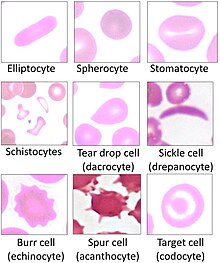Elliptocyte

blood film in a patient with hereditary elliptocytosis: approximately 60% to 70% of the RBCs are elliptocytes.

Elliptocyte compared to other forms of poikilocytosis.
Elliptocytes, also known as ovalocytes, are abnormally shaped red blood cells that appear oval or elongated, from slightly egg-shaped to rod or pencil forms. They have normal central pallor with the hemoglobin appearing concentrated at the ends of the elongated cells when viewed through a light microscope. The ends of the cells are blunt and not sharp like sickle cells.[1]
Causes[]
Rare elliptocytes (less than 1%) on a peripheral blood smear are a normal finding.[citation needed]
These abnormal red blood cells are seen in higher numbers in the blood films of patients with blood disorders such as:[2]
- Hereditary elliptocytosis and Southeast Asian ovalocytosis
- Thalassemia
- Iron deficiency
- Myelodysplastic syndrome and myelofibrosis
- Megaloblastic anemia
References[]
- ^ "Ovalocytes/Elliptocytes - LabCE.com, Laboratory Continuing Education". www.labce.com. Retrieved 21 May 2018.
- ^ Hirschmann, editors, Douglas C. Tkachuk, Jan V. (2007). Wintrobe's atlas of clinical hematology. Philadelphia, PA [etc.]: Lippincott Williams & Wilkins. ISBN 978-0781770231.
{{cite book}}:|first1=has generic name (help)
Categories:
- Disease stubs
- Cardiovascular system stubs
- Blood disorders
- Blood tests